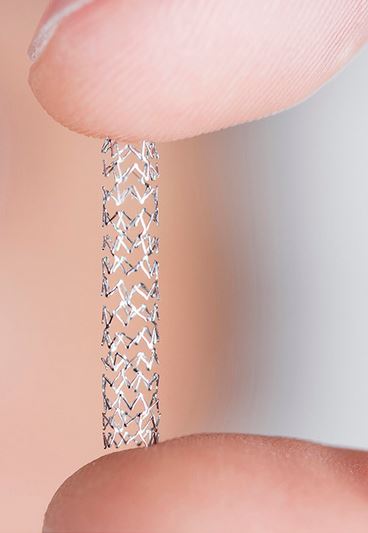
What is a heart stent?
Heart stent is metallic mesh, rolled in the form of a cylinder. The mesh resembles a chicken-wire (figure 1).

When is it used?
The heart stents are used if a blockage is identified in the artery of the heart which requires opening. As explained in the heart attack section, an opening of the blockage involves inflating a balloon across the obstruction, stretching the artery (figure 1).

A heart stent is then placed across the obstruction to keep the artery open (figure 3).

What happens next
Stent is a foreign body left in the artery, in contact with the blood. The stent gets covered with a layer of cells over time, isolating it from the blood. Until then, it is necessary to take certain blood thinners which prevent the platelets (clotting cells) from aggregating. If these medications are not taken as recommended, then the stent is at risk of attracting platelets on itself and clotting off.
Most of the stents used today have certain medications embedded within the mesh. These stents are called drug-eluting stents. The medication is released slowly in the vicinity of the stent. The medication acts to slow the process of plaque formation around the stent. A commonly held misconception is that this medication acts like a blood thinner to prevent clot formation, which is not true. The medicine prevents the plaque forming cells from growing in the vicinity, like a weed-killer.
These drug-eluting type stent require blood thinners to be taken for a longer duration than the ones without the drug. This is because the process of protective cell layer formation (as mentioned above) is also delayed. It is like the weed-killer slowing the growth of grass as well. Over longer duration, these stents usually perform better than the others.
Which blockages need to be treated
Not all blockages need to be treated.
- Small arteries cannot be treated with a stent because of their size. The artery would rupture if a larger stent is placed and then the situation could get worse.
- In less significant blockage, such as <50% blockage, a stenting procedure may not be needed. Most physicians would recommend medical treatment for them.
Important points
The stents are permanent and are not removed under most circumstances.
Stents require prescribed medications to be taken regularly to protect it.
Always consult your cardiologist prior to stopping your blood thinners for any reason, especially if the stent was placed within a year.
All opinions expressed here are those of the author and not of the employer. Information provided here is for medical education only. It is not intended as and does not substitute for medical advice.
Follow on twitter.
One Reply to “What is a heart stent?”
Comments are closed.